Originally posted on December 20, 2023 @ 8:13 am
Lard, a versatile cooking fat derived from rendered pork fat, is experiencing a resurgence among a new generation of cooks. Whether you’re a fan of flaky pie crusts, crispy fried chicken, or buttery biscuits, lard can be your secret ingredient for achieving delicious results. But where can you find this culinary gem in the grocery store?
Table of Contents
Key Takeaways:
- Not all grocery stores carry lard, so it’s best to call ahead or check online before heading out.
- If lard is available, you can typically find it in the meat section, near the cooking oils, or in the international aisle labeled as “manteca.”
- If you can’t find lard in your local grocery store, consider buying it from a butcher or exploring online options.
- Remember to consume lard in moderation as part of a balanced diet and consider alternative fats if preferred.
- Experiment with different fats to find the flavor and texture that suit your culinary preferences.
What is Lard and How is it Used?
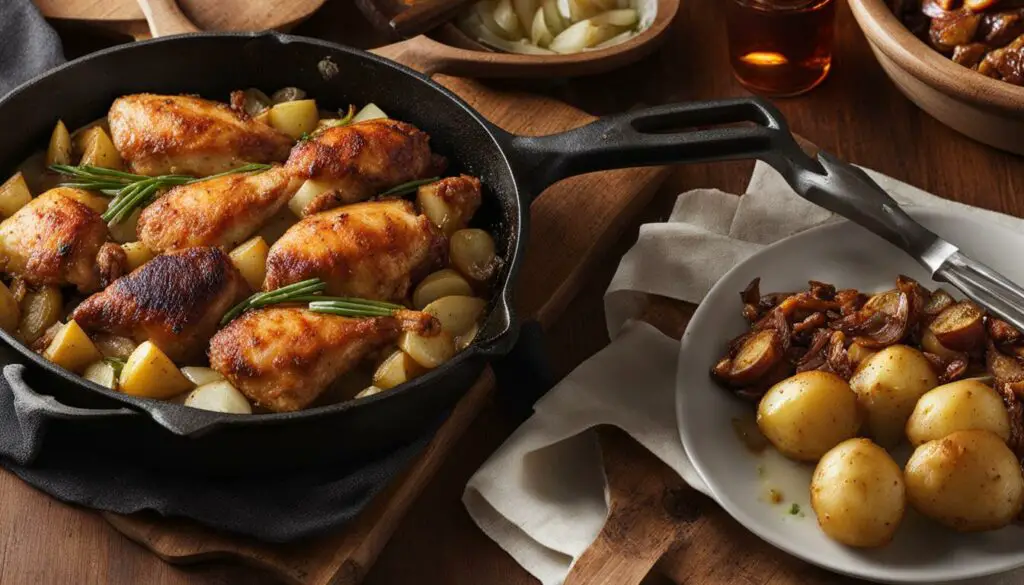
Lard is a cooking fat derived from rendered pork fat. It is commonly used in older recipes as a substitute for butter or other fats in cooking, deep-frying, or baking.
Lard has a high smoking point, making it perfect for achieving crispy, non-greasy fried foods. It is also known for creating flaky pie crusts and can be spread on toast as a butter alternative. Lard can add a unique flavor and texture to various dishes, making it a versatile ingredient in the kitchen.
“Lard has a high smoking point, making it perfect for achieving crispy, non-greasy fried foods.”
If you’re wondering how to incorporate lard into your cooking and baking, here are a few ways:
- Use lard as a fat for frying: Its high smoking point means it can withstand high temperatures without burning, resulting in deliciously crisp foods.
- Make flaky pie crusts: Lard is prized for its ability to create tender and flaky pie crusts. Many bakers swear by using it to achieve the perfect texture.
- Try it in biscuits and pastries: Lard can lend a rich and savory flavor to biscuits and pastries, making them extra delicious.
- Spread it on toast: Just like butter, lard can be spread on toast for a flavorful and unique twist.
- Use it in homemade tortillas: Lard can be a secret ingredient in homemade tortillas, adding both flavor and texture.
No matter how you choose to use lard in your cooking and baking, it’s important to remember that moderation is key. Lard, like any fat, should be enjoyed as part of a balanced diet.
Is Lard a Healthy Fat?
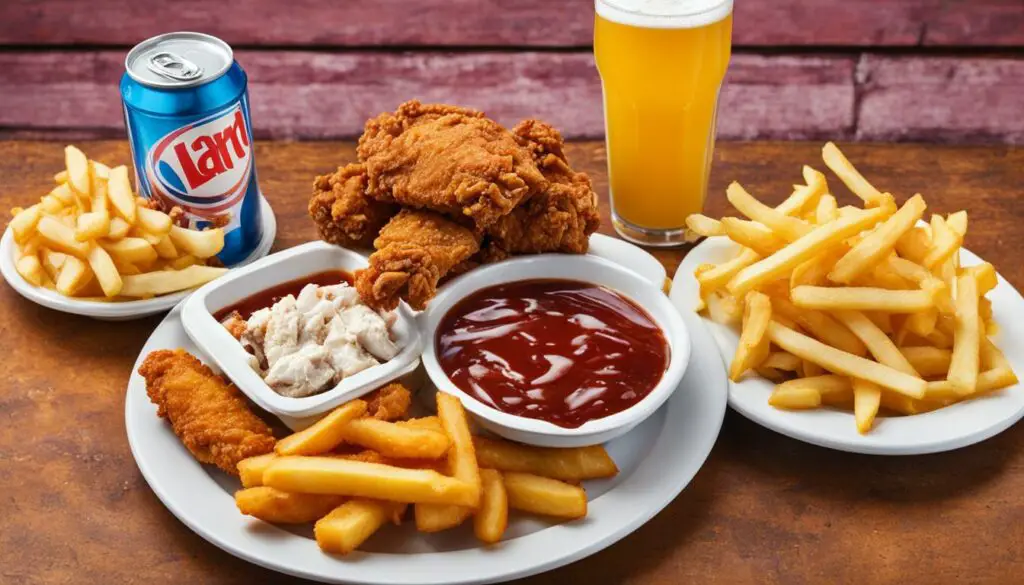
When it comes to considering the healthiness of lard, it’s important to understand that lard is a type of fat, and like any other fat, it contains calories and cholesterol. However, this doesn’t automatically classify it as unhealthy. The key lies in consuming fats in moderation as part of a balanced diet.
Despite its high cholesterol content, lard has certain nutritional advantages over other fats. Compared to butter, lard contains 20% less saturated fat and a higher concentration of monounsaturated fats, which are considered healthier for our bodies. Monounsaturated fats can help lower bad cholesterol levels and reduce the risk of heart disease.
However, it’s crucial to keep in mind that lard is calorie-dense, meaning it packs a significant number of calories in a small serving. Portion control becomes essential to avoid excessive calorie intake. Pairing lard with other healthy fats, such as olive oil, helps maintain a balanced fat profile in your diet.
To summarize, lard can be a part of a healthy diet if consumed in moderation and balanced with other nutritious fats. Let’s take a look at the nutrition facts of lard:
| Nutrient | Amount per 100g |
|---|---|
| Calories | 899 |
| Total Fat | 100g |
| Saturated Fat | 39g |
| Monounsaturated Fat | 45g |
| Polyunsaturated Fat | 11g |
| Cholesterol | 95mg |
Remember, incorporating lard into your cooking and baking can provide unique flavors and textures to your dishes. Just be mindful of portion sizes and consider combining it with other healthy fats for a well-rounded diet.
Where Do I Find Lard in the Grocery Store?
Not all supermarkets carry lard, so it is advisable to call ahead before searching for it. If your local grocery store does carry lard, you are likely to find it in tubs in the meat section, near the cooking oils, or in the international or Mexican foods aisle labeled as “manteca.”
It is important to note that if you find lard on an unrefrigerated shelf, it may have undergone a hydrogenation process, which can affect its nutritional profile.
If you are having trouble finding lard in a physical store, you can also consider searching for it online.
Can I Buy Lard from a Butcher?
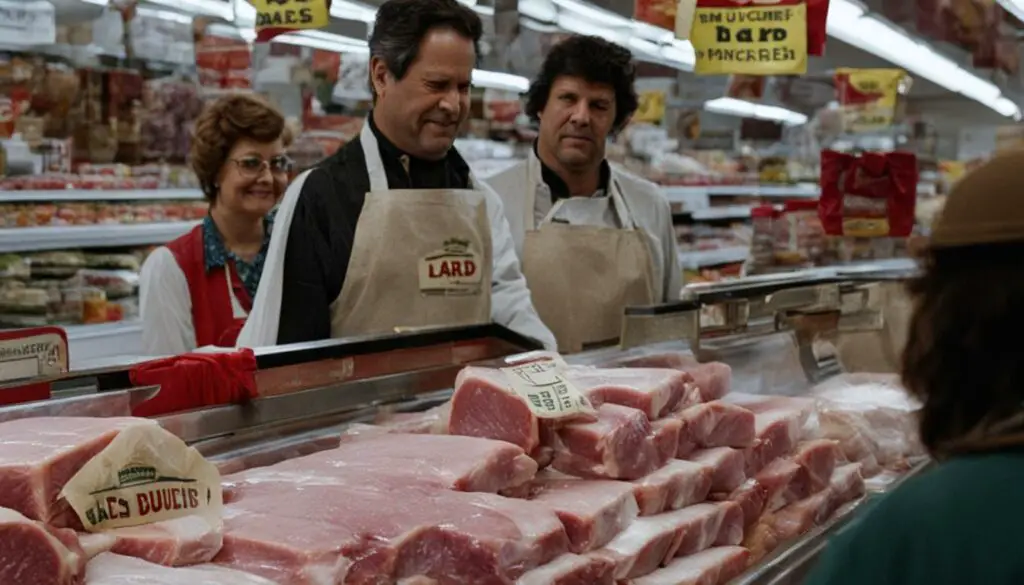
Yes, buying lard from a butcher is a great option if you’re looking for high-quality and unhydrogenated lard. In fact, butcher’s lard is often preferred by many home cooks and chefs due to its superior taste and texture.
When you purchase lard from a butcher, you can be confident that it hasn’t undergone any hydrogenation process, which can negatively impact its nutritional profile. This means that the lard you buy from a butcher is a healthier choice compared to commercially available options.
Another advantage of buying lard from a butcher is that you can request a specific cut of fat, such as back fat, which is ideal for rendering lard at home. Your butcher can provide you with a fresh piece of fat, ensuring that your homemade lard is of the highest quality.
Rendering lard at home is a straightforward process that allows you to control the quality and freshness of your cooking fat. Here’s a simple way to render lard:
- Cut the fat into small pieces or ask your butcher to do it for you.
- In a slow cooker or a heavy-bottomed pot, melt the fat over low heat. This process can take several hours, so be patient.
- Once the fat has completely melted, strain it through a fine-mesh sieve or cheesecloth to remove any impurities.
- Pour the strained liquid fat into a clean jar or container and let it cool to room temperature.
- Store the rendered lard in the refrigerator for up to six months.
By rendering lard at home, you can ensure that it is free from any additives or preservatives, making it a healthier option for your cooking and baking needs.
So, next time you visit your local butcher, don’t hesitate to ask for lard. Not only will you be supporting a local business, but you’ll also have access to high-quality, unhydrogenated butcher’s lard that you can conveniently render at home.
Where Else Can I Buy Lard?
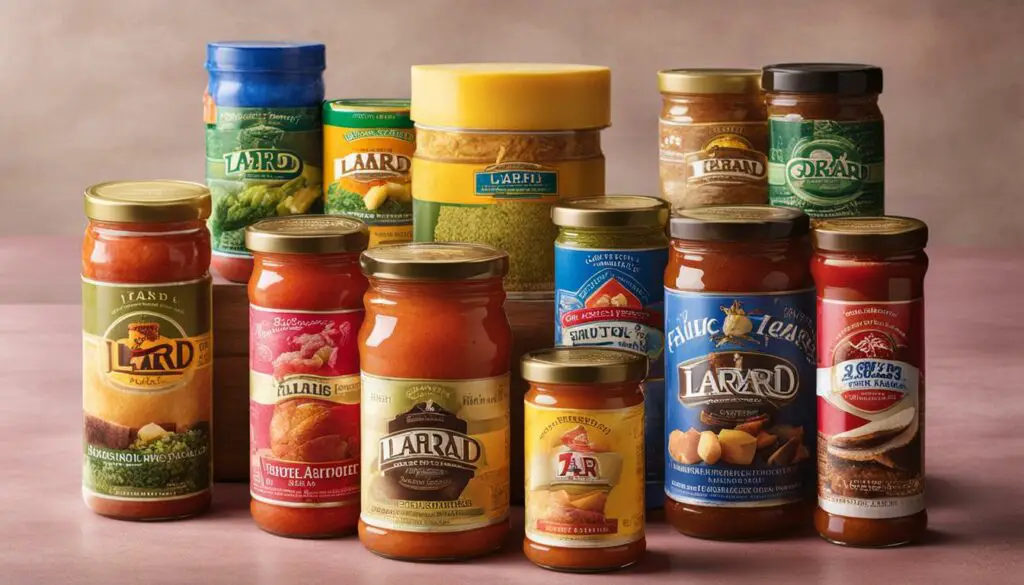
In addition to grocery stores and butchers, there are other options available for purchasing lard. You can explore different avenues such as farmers’ markets, direct purchases from farmers who raise their own pigs, and specialty brands found online. These alternatives provide unique opportunities to support local farmers while ensuring the highest quality lard for your culinary needs.
Buying Lard at Farmers’ Markets
If you enjoy the experience of shopping locally and connecting with farmers, farmers’ markets are a great place to find lard. Farmers’ markets often feature vendors selling a range of homemade and artisanal products, including lard. By buying lard from farmers’ markets, you can directly support local farmers and gain access to fresh, high-quality lard.
Ordering Lard Online
If you prefer the convenience of shopping from home, ordering lard online is a viable option. Many specialty brands and online retailers offer a wide selection of lard, allowing you to explore different brands and find the one that best meets your preferences. With just a few clicks, you can have high-quality lard delivered straight to your doorstep.
Specialty Lard Brands
When buying lard, you may come across several specialty brands known for their exceptional quality. Here are a few popular brands worth considering:
| Brand | Description |
|---|---|
| Fatworks | Offers a range of high-quality, grass-fed lard with various flavor profiles, including Leaf Lard, Pork Lard, and Beef Tallow. |
| Pasture Raised Leaf Lard | Specializes in pasture-raised leaf lard, known for its superior taste and texture in baking. |
| Fannie and Flo | Produces small-batch, hand-rendered lard using traditional methods to ensure exceptional quality and flavor. |
These specialty brands offer options for those who value specific qualities in their lard, such as sourcing and preparation methods. Exploring different brands can help you find the perfect lard for your cooking and baking endeavors.
Whether you choose to buy lard from farmers’ markets, online retailers, or specialty brands, you have a variety of options to ensure you have access to high-quality lard. Consider your preferences and priorities when making your selection, and enjoy the rich flavors and textures that lard can bring to your dishes.
What if I Can’t Find Lard?
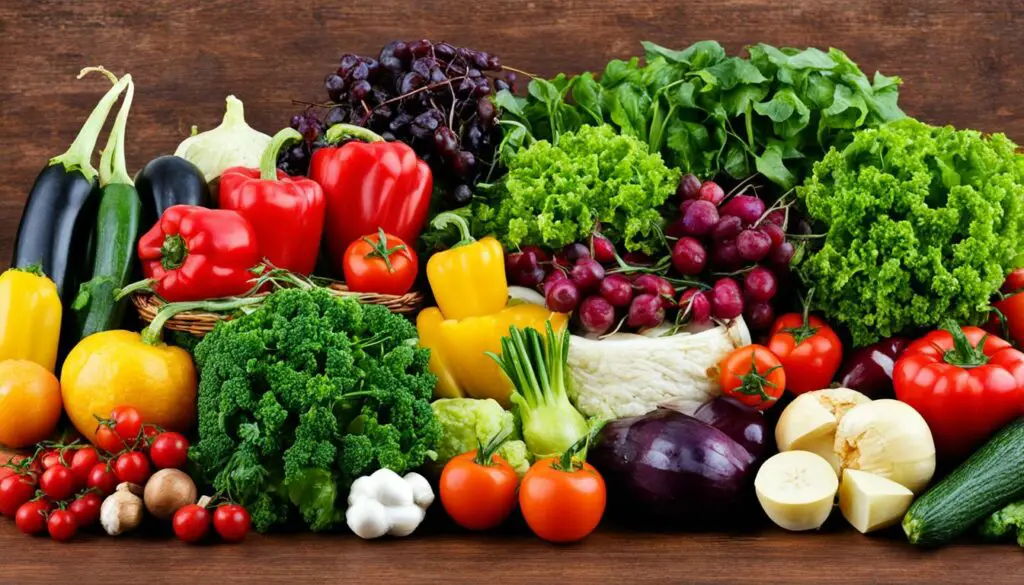
If you are unable to find lard or prefer to use different ingredients, there are several alternatives you can consider. For deep frying, you can use high-heat cooking oils like peanut or canola oil. For baking and pastries, butter or vegetable shortening can be used as substitutes for lard. These alternatives may not provide the exact same flavor and texture as lard, but they can still yield delicious results. It is important to experiment and find the alternative that best suits your tastes and dietary preferences.
If you’re looking for alternatives to lard, here are some options to consider:
| Alternative | Description |
|---|---|
| Peanut Oil | High-heat cooking oil suitable for deep frying |
| Canola Oil | Another versatile high-heat cooking oil for frying and baking |
| Butter | A rich and flavorful substitute for lard in baking and pastries |
| Vegetable Shortening | A solid fat that can be used in place of lard in pie crusts and other baked goods |
While these alternatives may not provide the exact same taste and texture as lard, they can still yield satisfying results in your cooking and baking endeavors. Feel free to experiment with different options and find the alternative that best suits your needs.
Is Lard the Same as Crisco?
When it comes to cooking fats, lard and Crisco are two popular options. However, they are not the same. Let’s explore the differences between lard and Crisco and how they can be used in your culinary endeavors.
Lard is derived from rendered pork fat and has a long history of being used in cooking and baking. It has a distinct flavor and texture that adds richness and depth to dishes. On the other hand, Crisco is a vegetable shortening made from palm oil and soybean oil. It is flavorless and has a smooth, creamy texture.
While both lard and Crisco can be used in pie crust recipes and for frying, they offer different results in terms of taste and texture. Lard has a mild, savory flavor that enhances the overall taste of the dish. Crisco, being flavorless, does not impart any specific taste but helps create flaky and tender baked goods.
Using Crisco as a substitute for lard can be a viable option in certain recipes. However, it is important to consider how the taste and texture may be affected. Lard adds a unique flavor profile, which may be missed when using Crisco. Additionally, the different melting points of lard and Crisco can impact the final texture of baked goods.
Here’s a quick comparison between lard and Crisco:
| Lard | Crisco |
|---|---|
| Derived from rendered pork fat | Vegetable shortening made from palm oil and soybean oil |
| Mild, savory flavor | Flavorless |
| Solid at room temperature | Soft and creamy |
| Higher smoking point | Lower smoking point |
As you can see, lard and Crisco have distinct characteristics that make them suitable for different culinary applications. The choice between the two ultimately depends on personal preferences and the desired outcome of the dish.
Conclusion
In conclusion, lard is a versatile cooking fat that has gained popularity among cooks looking to revive traditional recipes. While not all grocery stores carry lard, it can be found in the meat section, near the cooking oils, or in the international aisle labeled as “manteca.”
Alternatives to lard include cooking oils, butter, and vegetable shortening, although they may not provide the exact same flavor and texture. Ultimately, the choice of fat depends on personal preferences and dietary considerations. Whether you choose to use lard or explore other options, enjoy experimenting with different fats in your culinary endeavors.
FAQ
Where do I find lard in the grocery store?
Lard can typically be found in the meat section, near the cooking oils, or in the international aisle labeled as “manteca.”
What is lard and how is it used?
Lard is a cooking fat derived from rendered pork fat. It can be used in various recipes, such as fried chicken, pie crusts, and biscuits.
Is lard a healthy fat?
Lard contains calories and cholesterol, but it has less saturated fat than butter and a higher concentration of healthier monounsaturated fats. It should be consumed in moderation.
Can I buy lard from a butcher?
Yes, you can buy lard from a butcher. You can also ask for back fat to render your own lard at home.
Where else can I buy lard?
In addition to grocery stores and butchers, you can try purchasing lard at farmers’ markets or online from specialty brands.
What if I can’t find lard?
If you can’t find lard, you can consider using alternatives such as cooking oils or butter in your recipes.
Is lard the same as Crisco?
No, lard and Crisco are different. Lard is derived from pork fat, while Crisco is vegetable shortening made from palm oil and soybean oil.
Source Links
- https://www.countryliving.com/shopping/a27558216/where-to-buy-lard/
- https://www.themakeyourownzone.com/looking-for-lard-can-you-find-it-in-a-grocery-store/
- https://www.prevention.com/food-nutrition/a33407032/what-is-lard/
See also:
Leave a Reply